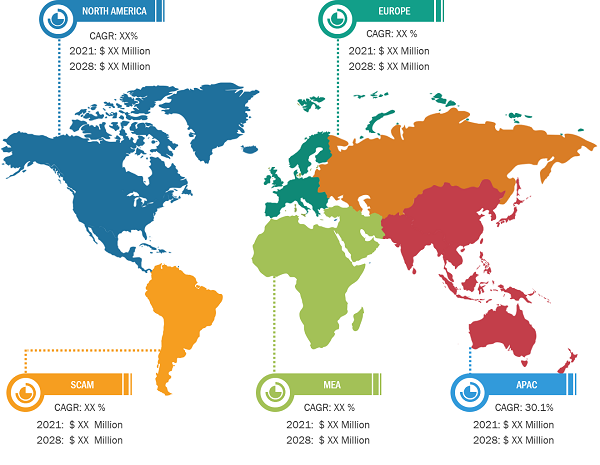Oral Segment to Lead Malaria Treatment Market During 2022–2030
According to our latest study on "Malaria Treatment Market Forecast to 2030 – Global Analysis – by Treatment, Route of Administration, and Distribution Channel," the market was valued at US$ 3,296.98 million in 2022 and is expected to reach US$ 24,487.73 million by 2030; it is estimated to grow at a CAGR of 28.5% from 2022 to 2030. The report highlights the key factors driving the market and prominent players with their developments. The market growth is primarily attributed to an increasing prevalence of malaria and the government and private sector's initiatives to raise awareness about malaria. However, counterfeit antimalarial drugs and subsequent drug resistance are hindering the market growth.
Governments of various countries across the globe with a high prevalence of malaria are deploying various strategies to eradicate the disease by improving access to healthcare services, including treatment options, to the people. A few of the initiatives undertaken are as follows:
Malaria Treatment Market Size and Forecasts (2020 - 2030), Global and Regional Share, Trends, and Growth Opportunity Analysis Report Coverage: By Treatment (Generic Drug, Originators, Vaccines, and Others), Route of Administration (Oral and Parenteral), and Distribution Channel (Direct Tender, Hospital Pharmacies, Retail Pharmacies, Online Pharmacies, and Others)
Malaria Treatment Market Growth Report by 2030
Download Free Sample
- Myanmar has a national malaria control plan that the Global Fund has approved, and by 2030, it is expected to eliminate the disease caused by P. falciparum. The universal healthcare coverage in the country also includes access to malaria diagnosis by means of microscopy or rapid diagnostic tests (RDTs) and artemisinin-based combination therapies (ACTs).
- The government of Thailand has implemented a National Malaria Elimination Strategy (NMES) 2017–2026 that further applies an integrated elimination strategy that aims to eradicate the disease by 2024.
- In January 2020, the Corporate Alliance on Malaria in Africa (CAMA) launched a strategic plan for 2021–2023 with an aim to reach millions of people through malaria control interventions and thereby scale up prevention activities in Africa.
- Thus, the abovementioned initiatives to spread awareness about malaria disease reinforce the eradication efforts to bolster the malaria treatment market growth.
Based on route of administration, the malaria treatment market is bifurcated into oral and parenteral. The oral segment held a larger share of the market in 2022, and it is also expected to grow rapidly during the forecast period. Oral drug delivery is the most preferred and suitable route of drug administration in malaria patients as it offers high patient compliance, noninvasiveness, least sterility constraints, cost-effectiveness, flexibility in the design of dosage form, and ease in the manufacturing process. Benefits such as ease of administration and long-term cost efficiency are major factors fueling the adoption of oral drugs. The low manufacturing cost of tablets, capsules, and other orally administered drugs acts as a driving factor for the malaria treatment market growth. A few of the available anti-malarial drugs are quinine, quinidine, chloroquine, amodiaquine, tafenoquine proguanil, chlorproguanil, and artemisinin. ACTs and combination therapies are being used for the treatment of uncomplicated malaria caused by P. falciparum parasite. ACTs are the most effective antimalarial medicines in the market, which is also responsible for the market growth in the oral segment.
Cipla Ltd, Sun Pharmaceutical Industries Ltd, Sanofi SA, GSK Plc, Novartis AG, Pfizer Inc, Emmaus Life Sciences Inc, AdvaCare Pharma USA LLC, VLP Therapeutics LLC, Lupin Ltd, and Teva Pharmaceutical Industries Ltd. are among the leading companies operating in the malaria treatment market.
The report segments the malaria treatment market as follows:
Based on treatment, the malaria treatment market is segmented into generic drugs, originators, vaccines, and others. Based on route of administration, the malaria treatment market is divided into oral and parenteral. Based on distribution channel, the malaria treatment market is segmented into direct tender, hospital pharmacies, retail pharmacies, online pharmacies, and others. By geography, the malaria treatment market is segmented into North America (the US, Canada, and Mexico), Europe (the UK, Germany, France, Italy, Spain, and Rest of Europe), Asia Pacific (China, Japan, India, Australia, South Korea, and Rest of Asia Pacific), the Middle East & Africa (Saudi Arabia, the UAE, South Africa, Kenya, Tanzania, Rwanda, Nigeria, Ghana, Uganda, Angola, Cameroon, Senegal, Zambia, and Rest of the Middle East & Africa), and South & Central America (Brazil, Argentina, and Rest of South & Central America).
Contact Us
Phone: +1-646-491-9876
Email Id: sales@theinsightpartners.com